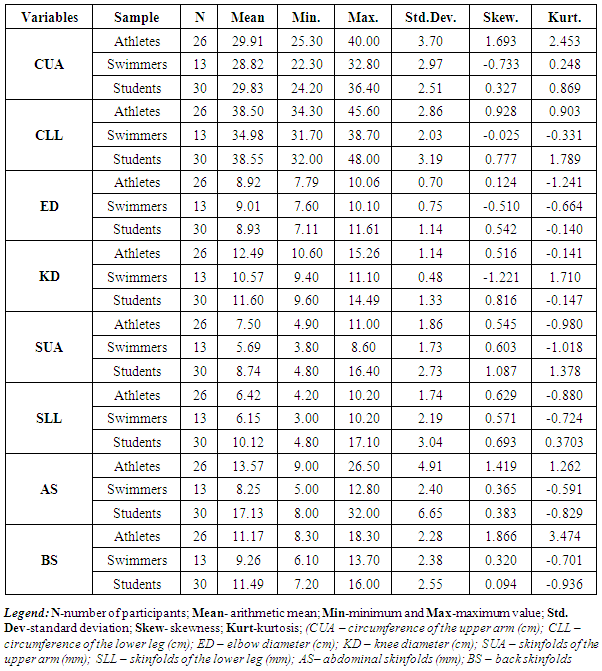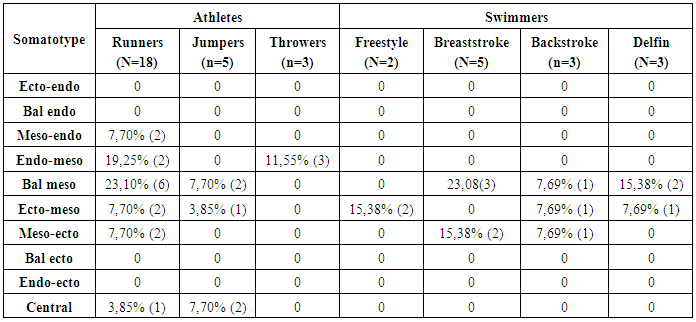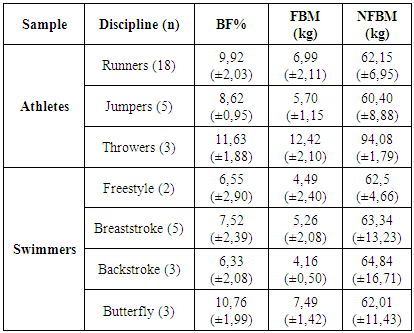-
Paper Information
- Next Paper
- Paper Submission
-
Journal Information
- About This Journal
- Editorial Board
- Current Issue
- Archive
- Author Guidelines
- Contact Us
International Journal of Sports Science
p-ISSN: 2169-8759 e-ISSN: 2169-8791
2018; 8(3): 67-77
doi:10.5923/j.sports.20180803.01

The Somatotypes and Body Composition of Elite Track and Field Athletes and Swimmers
Daniel Stanković1, Ratko Pavlović2, Emilija Petković1, Aleksandar Raković1, Miloš Puletić1
1Faculty of Sport and Physical Education, University of Niš, Serbia
2Faculty Physical Education and Sport, University of East Sarajevo, Republic of Srpska, Bosnia and Herzegovina
Correspondence to: Daniel Stanković, Faculty of Sport and Physical Education, University of Niš, Serbia.
| Email: |  |
Copyright © 2018 The Author(s). Published by Scientific & Academic Publishing.
This work is licensed under the Creative Commons Attribution International License (CC BY).
http://creativecommons.org/licenses/by/4.0/

The research was carried out on a sample of 26 elite Serbian track and field athletes (age 20.3±4,45yrs; height 181±7,81cm; weight 73,7±14,15kg, BMI 22,4±3,21kg/cm²), 13 swimmers (age 17±2,47yrs; height 178,3±8,24cm; weight 68,7±11,03kg; BMI 21,5±1,98kg/m²) and 30 students of the Faculty of Sport and Physical Education in Niš (age 20,3±0,13yrs; height 180,1±1,56cm; weight 75,5±2,17kg; BMI 23,2±0,44kg/m²), all males, attending their first year at university (30), with the aim of determining their somatotype and body composition. The obtained results have confirmed that in the case of the athletes, we found several somatotypes: the balanced mesomorphic and endo-mesomorphic (30,8%), a central somatotype and ecto-mesomorphic somatotype (11,5%) and to a significantly smaller percentage, meso-endomorphic and meso-ectomorphic components (7,7%). In the case of the swimmers, three types of somatotypes were found: the balanced mesomorphic (46,15%), ecto-mesomorphic (30,77%) and meso-ectomorphic (23,08%) which defined a homogenous group. The students were defined by all forms of somatotypes, except the endo-ectomorphic (meso-endomorphic (33,33%), endo-mesomorphic (23,33%), while the other types were found in a much smaller percentage, which determined the heterogeneity of the group. The analysis of the body composition has indicated that all three components are greater among the students compared to the track and field athletes and swimmers, that is, that the students weigh more than the athletes, and the athletes weigh more than the swimmers. In the case of the track and field athletes, all three components are significantly greater among the throwers compared to the runners and jumpers, whose values are smallest. In the case of the swimmers, it was determined that BF% and FBM are greater for the butterfly style, while the NFBM is smaller compared to the other swimming styles. The multivariate analysis between the groups of athletes (track and field and swimmers) and the control group (students) for the variables BF%, FBM, NFBM, did not show any statistically significant differences, although the significance of the difference was right on the borderline value (p=0.058). At the univariate level, a statistically significant difference was noted between the group of athletes (track and field and swimmers) and the control group (students) for the variables BF%, FBM, NFBM. A statistically significant greater difference (p<0,05) was noted for BF% and FBM in favor of the students, while for the NFBM there is no statistically significant difference, which indicates that greater weight is a consequence of the greater amount of fat tissue.
Keywords: Body composition, Somatotypes, Elite sport, Differences
Cite this paper: Daniel Stanković, Ratko Pavlović, Emilija Petković, Aleksandar Raković, Miloš Puletić, The Somatotypes and Body Composition of Elite Track and Field Athletes and Swimmers, International Journal of Sports Science, Vol. 8 No. 3, 2018, pp. 67-77. doi: 10.5923/j.sports.20180803.01.
1. Introduction
- The first data on the human somatotype originate from Ancient Greece and Hippocrates, and then from the Roman physician Galen in the 1 AD, while other important scientists who dealt with the question of constitution worked on this problem in the 19th and 20th century. They contributed to the design of what is today the most frequently used Heath-Carter method for determining the human somatotype. The first data on the three components of the somatotype, endomorphic, mesomorphic and ectomorphic, date back from Sheldon [1], and were accepted and modified by American scientists Heath and Carter. The aforementioned authors, based on certain anthropometric parameters, determined a somatotype by applying a formula, table and nomogram [2-5]. The somatotype was defined as the quantification of the current shape and composition of the human body expressed in the form of three numbers which shown the endomorphic, mesomorphic an ectomorphic component, always following the same order [6]. The endomorphic component is connected to the amount of fat tissue, the mesomorphic with muscle mass, and the ectomorphic with the relations between body height and weight. When one of the components is dominant, then we are dealing with “clean types”. Some authors claim that constitution is solely linked to one's genetic makeup; however, it is certain that the development of the somatotype also depends on other, internal and external factors [7]. It was Philostratus Flavius in Ancient Greece who described how an athlete returning from the Olympic Games as a victor should be built [8]. In the literature we find opposing viewpoints on the part played by somatotypes for success in sport, but certainly predisposition is a piece of the mosaic which will, along with other factors (the training process, diet, motivation) be relevant for success; as Tanner says “an athlete is born and created” [9]. A large number of studies indicate that anthropometric research which also includes the somatotype indicates differences among athletes, and that they depend on the type of sports activities and rank of the competition. In sports dominated by strength, the mesomorphic component is characteristic, for example in field judokas [10], while in the case of sports climbers, their somatotype is mesomorphic/ectomorphic [11] and ectomorphic/mesomorphic [12]. The mesomorphic component is attached to individual sports which require muscle force, and the ectomorphic for collective ones where the requirements are precision and skill. However, there are also significant differences within the same sport, depending on the playing position [13].When it comes to field and track athletes, the mesomorphic somatotype is the most frequent one, with modifications towards the endo-mesomorphic and meso-ectomorphic characteristics, depending on the discipline the athlete is involved in. The mesomorphic component is tied to muscle strength which is necessary for top results among runners, jumpers and throwers [5, 14]. The analyses of somatotypes of the participants in the Olympic Games from 1948 to 1976, and the winners of other international competitions, or participants who were highly ranked, indicated a central somatotype (men approximately 2-5-2,5, and women approximately 3-4-3). A comparison of athletes of both genders competing in all the Olympic Games with referent groups indicates that they are more of the mesomorphic type, and less of the endomorphic [3, 15]. The analysis of the somatotypes of athletes at national competitions indicates a deviation from the central somatotype, which is characteristic for sportsmen with top Olympic results, as was stated in the beginning, and range from, depending on the sports discipline, a dominant component to one of the two remaining components. It is considered that the differences in somatotypes in national sports is a consequence of the differences in technical equipment, the racial and ethnic backgrounds of the sportsmen, socio-economic status, the selection methods and the training process. Thus, the differences in somatotypes in national selections make a comparison difficult. What can be found is a greater variety in somatotypes among young sportsmen of both genders, more so than among the older ones, and less sexual dysformism among younger than among older sportsmen [5].An analysis of elite swimmers shows that the mesomorphic somatotype (2,5-5-3) is present, and that there are also differences in the swimming styles [4]. The somatotype of the boys is mesomorphic with a tendency towards the ectomorphic component, and the intense training process changes the somatotype in around 50% of the boys in favor of the mesomorphic component and decreases endomorphism [16, 17]. A difference in the somatotypes among swimming styles was also determined, as was the fact that young swimmers have a tendency of being less mesomorphic and more ectomorphic [18, 19]. What was also determined were differences between boys and girls freestyle sprinters, but only in % fat (boys = 9.40 ± 5.35 % fat; girls = 12.73 ± 6.19 % fat) and the endomorphic component (boys = 2.87 ± 0.96; girls = 4.29 ± 1.22) [20]. In addition, it was determined that swimmers with top results are central somatotypes with a tendency of decreasing the endomorphic and increasing in the ectomorphic component, and that somatotypes are included in the selection process of potential elite swimmers [21]. The determination of a somatotype is performed during childhood, and during adolescence, for the purpose of focusing young people on the sport which would suit their constitution [22]. It is linked to certain medical conditions such as heart disease [23], is analyzed in eating disorders and dyspepsia, [24]. A difference is noted in the somatotypes of the students of the faculty of sport, and of other faculties [25], as well as between sportsmen and non-sportsmen, and for various sports disciplines [13, 26]. Numerous analyses indicate that somatotypes are susceptible to change which influences the way of life and biological acceleration [8, 27]. Determining the physical structure of human subjects is a frequently used method in not only different medical disciplines, but also in sports sciences, anthropology and pedagogy [8, 28]. Most of the attention is focused on determining the content of the fact component, primarily with the aim of evaluating the health risk or quality of the sports performance; however, there are justifiable reasons for determining the content of the other components of the physical structure of the body [28]. The overall body mass is divided into non-fat body mass (muscles, the skeleton, internal organs), the fat body mass (essential fats – lipids in the cells, and non-essential fats – subcutaneous fat and the fat between internal organs), which gives us a two-component model of bodily composition, while the percentage of body fat is determined based on the tables provided by Jackson and Pollock [29].Based on the aforementioned, the aim of the research is to determine the somatotypes and body composition of elite national track and field athletes and swimmers. Based on the set goal of the research, in this paper we will determine the somatotypes and their percentages in a sample of elite Serbian track and field athletes and swimmers who achieved national results, and among the students of the Faculty of Sport and Physical Education who do not take part in elite sports activities and who will be included for the purpose of comparison. The national system of competition allows students to compete in top-level and university sports, and we needed to clarify the difference between top level (elite) and university sport in our country. Also, we will determine the % of body fat, and the weight of the fat and non-fat component for the same sample. We will determine the somatotypes and body composition based on the choice of discipline of the track and field athletes and swimmers. For the group of students, we will determine their somatotypes and body composition, as for the sportsmen. We will determine any differences among the sportsmen (track and field athletes and swimmers) and students who are not elite sportsmen.
2. Materials and Methods
- Several studies have been carried out from May to June of 2011, in cooperation with the Athletics and Swimming Association of the Republic of Serbia. The sample included 26 elite Serbian athletes (age 20.3±4,45yrs; height 181±7,81cm; weight 73,7±14,15kg, BMI 22,4±3,21kg/cm²) and 13 swimmers (age 17±2,47yrs; height 178,3±8,24cm; weight 68,7±11,03kg; BMI 21,5±1,98kg/m²) with significant results at the national level. The control group was represented by male students (N=30) of the Faculty of Sport and Physical Education in Niš, all first-year students (age 20,3±0,13yrs; height 180,1±1,56cm; weight 75,5±2,17kg; BMI 23,2±0,44kg/m²), who were not elite sportsmen and who had not actively taken part in any sports activities during the testing period. All subjects were participants in the project which was given by the Ministry of Education, Science and Technological Development of the Republic of Serbia, for financing the project “Biomechanical Efficiency of the Elite Serbian Athletes” (OI 179019). The participants were informed beforehand about the goals, activities and time needed for the study, and their approval was obtained for voluntary participation in the research. The experimental procedureWe determined the age, height, weight and BMI of the participants. Of the anthropometric parameters we determined the diameters of the elbow (epicondylar distance) and knee (bicondylar distance), as well as the circumference of the upper arm and lower leg [30]. The skinfolds were measured on the back, subscapularly, on the thorax (diagonally at the mid-point between the beginning of the frontal axillary line and the mammillae), on the abdomen, a suprailiac measurement, on the upper arm above the triceps and on the lower leg, medially. The diameters were determined in the digital program ImageJ [31] on the digital photoFigures taken of the participants in the frontal aspect with a “Casio FX”. camera; the camera was set up at the necessary height and distance from the participant, always in the same way and under the same conditions [32, 33]. Reliability of digitalization of the body images using ImageJ become dominant during the past 10 years; digital imaging applied in anthropometry is important for understanding the human body and posture (34). A large number of image processing tools with varied capabilities are available. ImageJ, which is available as a freeware, is such a tool. It is a public domain, Java-based image processing program developed at the National Institutes of Health. ImageJ was designed with an open architecture that provides extensibility via a Java plug-in and recordable macros [35].The weight of the participants was measured with a classic scale and is expressed in kilograms. The height was determined by an anthropometer and is expressed in centimeters.The circumferences were measured by a measuring tape in cm, and the skinfolds by means of a caliper in mm. The measuring tape and caliper are component parts of the GPM – Swiss Made anthropometric set. The somatotypes were determined in the program SOMATOTYPE 1.1 [36], and in accordance with the Heath-Carter method [2, 3, 4, 37]. Body mass index (BMI) was determined according to the National Heart, Lung and Blood Institute – USA [38]. The percentage of fat tissue was determined according to the Jackson and Pollack method, based on body height and the sum of three skinfolds (on the back, the front of the thorax and above the triceps) by using the appropriate tables [29]. In addition, the fat and non-fat body component was determined (the two-component model of body composition) based on the percentage of body fat which was expressed in kg.The obtained quantifiable data were statistically processed in the statistical program SPSS 10 which was used to determine the means, standard deviation, and maximum and minimum measured value. The statistical significance was tested using the multivariate and univariate One-way ANOVA test, at the level of statistical significance of p<0,05.
3. Results
- Based on the defined sample of participants it is clear that according to their age, the field and track athletes and students are almost identical (20,3 yrs), while the swimmers are younger (17 years of age). In addition, the height of the track and field athletes and students is almost the same (180-181cm), while it is smaller among the swimmers (178,3cm). The highest values of weight were recorded for the students (75,5kg), then for the track and field athletes (73,7kg), and is smallest for the swimmers (68,7kg), which is understandable since the swimmers are younger and have smaller body weight. Most of the participants were in the normal weight category, 18.5-25, but in all three studied groups, 1 to 2 individuals were in the category of under 18,5, and only from the group of track and field athletes and students were there individuals who were in the category of above 25. The displayed results of the BMI confirm that students have greater body weight than the track and field athletes, and that the swimmers have the lowest weight (Figure 1). A more detailed insight into this problem will be provided in the analysis of body composition.
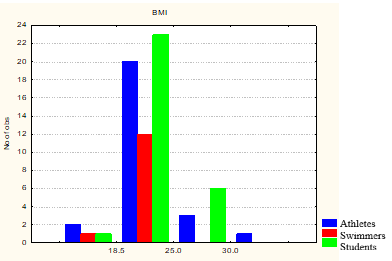 | Figure 1. Body Mass Index (Malnutrition <18.5; Normal 18.5-25; Excessive nutrition 25-30; Obesity>30) |
|
|
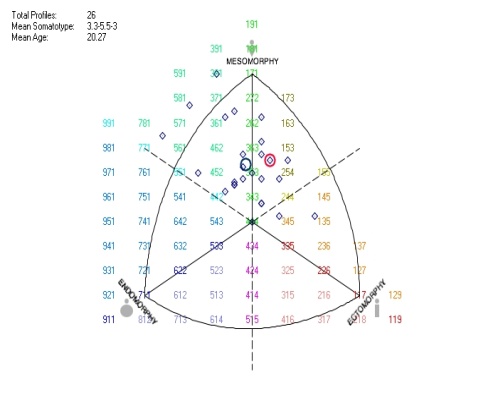 | Figure 2. Somatogram of the athletes |
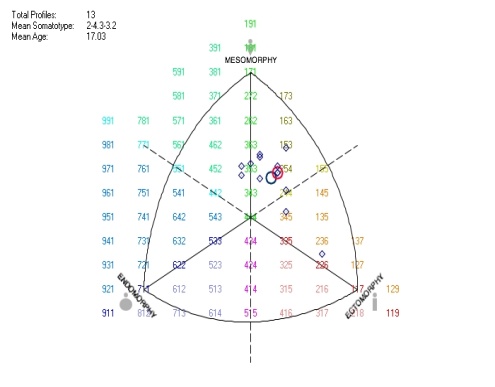 | Figure 3. Somatogram of the swimmers |
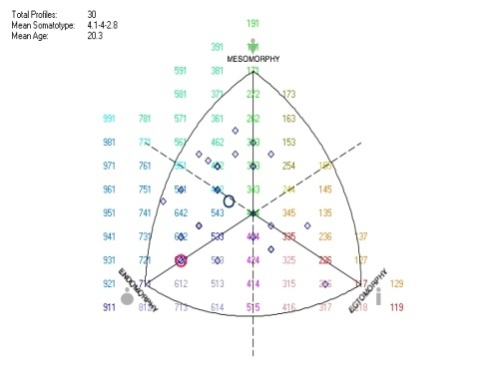 | Figure 4. Somatogram of the students |
|
|
|
|
|
4. Discussion
- Making anthropological measurements, determining constitution, somatotypes, and body composition in elite sport is very important for the selection process of cadets for a certain sport or discipline, monitoring the training process, the objective evaluation of general physical development, control of the state of nutrition of the sportsmen, and monitoring sportsmen's recovery during the rehabilitation process. Our research, which is based on the Heart-Carter method and which relied on the use of the digital program Somatotype 1.1, has indicated that there is a need to determine somatotypes. The studied track and field athletes with top results at the national level of competition all had a basic mesomorphic component; 30,8% are balanced mesomorphic and in the same percentage endo-mesomorphic. Only 11,55% are central somatotypes. Among the track and field athletes the mesomorphic somatotype is prevalent with a modification towards the endo-mesomorphic and meso-ectomorphic characteristics, depending on the type of activity. The mesomorphic component is bound to muscle strength, which is necessary for top results for runners, jumpers and throwers [5]. The analyses of somatotypes of participants in the Olympic Games (since 1948 in London to the Olympic Games in Montreal) and the participants of other international competitions who won medals or were highly ranked showed that they are grouped around the 2-5-2,5 somatotype for the men and 3-4-3 for the women, that is, that they are central somatotypes. A comparison of the sportsmen of both genders competing in the Olympic Games and the reference groups indicates that they are more mesomorphic and less endomorphic [3, 14, 15]. The results of our track and field athletes are not top Olympic results and so that is why the central somatotype is present in a much smaller percent. An analysis of the somatotypes of sportsmen at national competitions, such as our sample of studied track and field athletes, indicates a deviation from the central somatotype, which is characteristic for sportsmen with top Olympic results, as was mentioned before, and ranges, depending on the sports discipline, from the dominant component to on one or two of the remaining components. The average somatotype for all the studied athletes in our research is 3,3-5,5-3,0 which belongs to the category of the balanced mesomorph (table 3). In our research, the analysis of somatotypes based on the track and field disciplines (table 4) indicates that all the throwers were endo-mesomorphic, that is, that they are a homogenous group, which is in accordance with the findings of other authors [39, 40]. Among the jumpers we find a central somatotype, balanced mesomorphic and ecto-mesomorphic, as is cited in the findings on a sample of track and field athletes in India [41]. In our sample, the short and middle distance runners were dominantly balanced mesomorphic and endo-mesomorphic, and the other types were represented to a smaller percent and lean towards the ecto-mesomorphic component, as was determined for short and middle distance sprinters of the university rank in India [41] and Croatia [14]. Our research has also indicated that an increased distance from Olympic champions which are central somatotypes, as was cited by Carter, a descent to the national level, as in the case of our sample, leads to a distancing from the central somatotype, and allows for numerous other combinations to be found. Based on our insights from table 6. we can conclude that the percentage of body fat among our participants was the lowest for the jumpers, then the runners and the greatest for the throwers (11,63%), while some authors point out that the lowest % of fat is found among sprinters, and the greatest among throwers [14, 40].Our sample of swimmers indicates signs of being the most homogenous group in terms of somatotypes; we find examples of the balanced mesomorphic in the highest percentage (46,15%), followed by the ecto-mesomorphic and meso-ectomorphic (table 2. and Figure 3.), and it is clear that the mesomorphic component is dominant and that it leans towards the ecto-mesomorphic. The analysis of elite swimmers from 1960 to 1980 indicates a dominant mesomorphic somatotype is (2,5-5-3). The backstroke swimmers from the Olympic Games in 1968 are less mesomorphic and more ectomorphic, compared to swimmers of other styles, while no racial differences were determined. The reduction in endomorphism over the last 20 years is a consequence of long-term and intensive training, as stated by Carter [4]. The anthropometric and physiological characteristics of young male and female swimmers, potential Olympic swimmers, were studied, with a special look at their somatotype [16, 20], and it was pointed out that the somatotype of the boys is mesomorphic with a tendency toward the ectomorphic component. Within the same study, anthropometric and somatotype characteristics were also studied, along with their changes prior to and following a three-month intensive training program [17] where it was indicated that the studied characteristics significantly alter after intense training in favor of the mesomorphic component which increases, while the endomorphic one decreases. Still, the changes were found in only 50% of the boys, while for the other half no statistically significant changes were determined. Differences in the somatotype among the swimming styles were pointed out by Araujo, who found that breaststroke swimmers are more mesomorphic than freestyle swimmers, who are low endomorphic. Furthermore, backstroke swimmers are more ectomorphic compared to others [18], which is also one of the result of our research (table 4.). The same author points out that young swimmers have a tendency of being less mesomorphic and more ectomorphic than adults; it has also been indicated that young swimmers aged 8, 11, 15, 19 are balanced mesomorphic (3,0-4,9-2,9), and that the older groups are ecto-mesomorphic [19]. In a study of twelve-year-old Hungarian swimmers, it was determined that they were more mesomorphic and ectomorphic (2,5-4,4-4,4), which can be explained by the extensive training process [42]. Among female swimmers (19,7 years old) and male swimmers (20,5 years old) who swim different styles in a range of national competitions, the relationship between the performance of the swimmers, body composition, and somatotypes was studied during pre- and post-season training [43]. It was determined that the findings indicate that the somatotypes and body composition can be relevant for the female, but not for the male swimmers. In his work, Babington [21] studied the influence of somatotype characteristics (age, height, weight, somatotype, arm length, body maturation) among male and female swimmers in the selection of potential elite swimmers. What was studied were swimmer characteristics from the Olympic Games from 1964 to l995, and it was determined that the swimmers with top results were central somatotypes with a tendency towards a decrease in the endomorphic and increase in the ectomorphic component. In our research there was no central somatotype among the swimmers, but the balanced mesomorphic was to be found for the breaststroke, backstroke and butterfly style and a combination of the mesomorphic and ectomorphic component. The freestyle swimmers were only ecto-mesomorphic (15,38%). The percentage of fat tissue among the swimmers is the lowest compared to the track and field athletes and students, and the percentage of fat was somewhat greater only for the butterfly style (10,76%). Based on the somatotypes we can consider the swimmers to be adequately selected, and with the appropriate training process it can be expected that good results will be achieved, even more significant than the national ones. The analysis of the somatotypes of the group of students of the Faculty of Sport and Physical Education who are not elite sportsmen who achieved top results at the national level indicates a great heterogeneity, that is, all the basic types and their combinations can be found, while the % of fat tissue is incomparably greater than in the sample of sportsmen. The average somatotype is mesomorphic-endomorphic (4,1-4,0-2,8), which indicates the domination of the muscle and body fat component. In a paper which analyzes the somatotype of the students of the Faculty of Sport and Physical Education attending college in 1997, and ten years after that, in 2007, indicates that the somatotype in both groups is endo-mesomorphic, but with an increased endomorphic component for the 2007 generation [27], which indicates smaller muscle mass and greater amount of fat tissue, which is evident in our research as well; the percentage of fat tissue among the students is 10,93%, while among the track and field athletes it is 9,73% and the swimmers 7,85% (table 5).The analysis of the percentage of body fat between the sportsmen (track and field athletes and swimmers) and students (non-sportsmen) indicates statistically significant differences (p≤ 0,05) for TM% and TM(kg), which is in accordance with the findings of other authors [26, 27, 44, 45], and is explained by the intensity of the training process [46], better selection based on the anthropometric characteristics and an the adequate diet of sportsmen compared to non-sportsmen. Even among other sportsmen such as Greco-Roman wrestlers, a difference in the somatotypes between trained and untrained participants can be noted (2,0-6,6-1,2 vs. 3,7-4,5-3,1), while differences are present even in the percentage of fat tissue (12,1% vs. 15,7%, t = 7,84, p≤0,001), which indicates greater obesity among the untrained participants [47].In future studies we will analyze what kind of results are achieved by individual participants in various research, whether the somatotype changes [46] and whether the % of fat changes, along with fat and non-fat body component following a period of one year or several years, and will compare the results. We also consider that future research should include the functional characteristics of sportsmen.
5. Conclusions
- The research was realized on a sample of elite Serbian sportsmen, swimmers of the Faculty of Sport and Physical Education in Niš, all males, all first-year students, with the aim of determining their somatotypes and body composition. Based on the obtained results we can conclude the following: Among the track and field athletes we find several types of somatotypes. The most frequent are the mesomorphic and endo-mesomorphic (30,8%), a central somatotype and ecto-mesomorphic somatotype (11,5%) with a significantly smaller percentage of meso-endomorphic and meso-ectomorphic components (7,7%).Among the swimmers, three somatotypes are to be found, dominated by the balanced mesomorphic (46,15%), followed by the ecto-mesomorphic (30,77%) and meso-ectomorphic (23,08%), which defined a homogenous group.The students were defined by all the somatotypes, except the endo-ectomorphic. The most frequent is the meso-endomorphic (33,33%) and endo-mesomorphic (23,33%), while the others are present to a significantly smaller percentage, which defined the heterogeneity of the group. The analysis of the distribution of individual somatotypes among track and field athletes indicates the dominance of the mesomorphic component with a tendency towards the ectomorphic and endomorphic, while among the swimmers the mesomorphic component is dominant (of the central type) with a tendency towards the ectomorphic, while among the students we find all combinations of somatotypes. What predominates is the mesomorphic component, with a tendency towards the ectomorphic and endomorphic. The runners emerged as a heterogenous population in terms of somatotypes, and are predominantly balanced mesomorphic and endo-mesomorphic. The jumpers are balanced mesomorphic, central somatotype and ecto-mesomorphic, while the throwers are a very homogenous population with the endo-mesomorphic somatotype. Among the swimmers, the balanced mesomorphic was determined for the breaststroke, butterfly and backstroke style, the ecto-mesomorphic somatotype for the freestyle, backstroke and butterfly, while the meso-ectomorphic somatotype was determined for the breaststroke and backstroke style of swimming. The analysis of physical status (BF%, FBM, NFBM) has indicated that all three components are greater among the students compared to the track and field athletes and swimmers, that is, that the students are heavier than the track and field athletes, and the athletes are heavier than the swimmers. Among the track and field athletes, all three components are much greater for the throwers compared to the runners and jumpers, where the values are the smallest. Among the swimmers we can see that the BF% and FBM are greater for the butterfly, and that the NBFM is smaller compared to the other styles. A multivariate analysis between the groups of sportsmen (track and field athletes and swimmers) and the control group (students) for the variables BF%, FBM, NFBM, has not indicated any statistically significant differences, even though the significance of the difference was right below the borderline value of statistical significance (p=0.058). At the univariate level, we noted a statistically significant difference between the group of sportsmen (track and field athletes and swimmers) and the control group (students) for the variables BF%, FBM (kg), NFBM (kg). We found a statistically significant difference (p<0,05) which was greater for the BF% and FBM in favor of the students, while for the NFBM there is no statistically significant difference, which indicates that the greater weight is a consequence of a greater amount of fat tissue.
References
| [1] | Sheldon WH, Stevens SS, Tucker WB. The varieties of human physique: An introduction to constitutional psychology, 1940; New York: Harer and Brothers. |
| [2] | Heath BH, Carter JE. A modified somatotype method. American journal of physical anthropology, 1967; 27(1): 57-74. |
| [3] | Carter JE, Ross WD, Duquet W, Aubry SP. Advances in somatotype methodology and analysis. American Journal of Physical Anthropology, 1983; 26(S1): 193-213. |
| [4] | Carter JEL. Somatotypes of Olympic athletes from 1948 to 1976. U.J.E.L. Carter (Ed.), Physical structure of Olympic athletes. Paer II: Kinanthropometry of Olympic athletes (80 – 109), 1984; Basel: Karger. |
| [5] | Carter JEL, Hearth BH. Somatotyping – development and applications. Cambridge Studies in Biological Anthropology, 1990; Cambridge University Press, Cambridge-New York-Port Chester-Melbourne-Sydney. |
| [6] | Carter, JEL. The Heath-Carter anthropometric somatotype: instruction manual, 2002; San Diego: San Diego State University. |
| [7] | Bouchard C, Demirjan A, Malina RM. Heritability estimates of somatotype components based upon familial data. Human Heredity, 1980; 30: 112-118. |
| [8] | Mišigoj-Duraković M. Kinantropologija-biološki aspekti tjelesnog vježbanja [Kinantropologija-biological aspects of physical exercise. In Croatian], 2008; Zagreb: Kineziološki fakultet. |
| [9] | Tanner JM. The physique of the Olympic athlete... Rome, 1960, 1964; London: George Allen and Unwin Limited. |
| [10] | Lewandowska J, Buśko K, Pastuszak A, Boguszewska K. Somatotype variables related to muscle torque and power in judoists. Journal of human kinetics, 2011; 30: 21-28. |
| [11] | Viviani F, Calderan M. The somatotype in a group of “top” free-climbers. The Journal of Sports Medicine and Physical Fitness, 1991; 31(4): 581-586. |
| [12] | Alvero-Cruz JR. Somatotipo, masa grasa y muscular del escalador Deportivo Español de elite. International Journal of Morphology, 2011; 29(4): 1223-1230. |
| [13] | Raković A, Savanović V, Stanković D, Pavlović R, Simeonov A, Petković E. Analysis of the elite athlete’s somatotypes. Acta Kinesiologica, 2015; 9(Suppl 1): 47-53. |
| [14] | Vučetić V, Matković B, Šentija D. (2008). Morphological differences of elite Croatian track-and-field athletes. Collegium antropologicum, 2008; 32(3): 863-868. |
| [15] | De Garay AL, Levine L, Carter JEL. Genetic and anthropological studies of Olympic athletes, 1974; New York: Academic Press. |
| [16] | Bagnall KM, Kellett DW. A study of potential Olympic swimmers: I, the starting point. British journal of sports medicine, 1977; 11(3): 127-132. |
| [17] | Kellett DW, Willan PL, Bagnall KM. A study of potential Olympic swimmers. Part 2. Changes due to three months intensive training. British journal of sports medicine, 1978; 12(2): 87-92. |
| [18] | Araujo CGS. Somatotyping of top swimmers by the Heath-Carter method. In Swimming Medicine IV, ed. B. Erickson & B. Furberg, 1978; pp.188-198. Baltimore: University Park Press. |
| [19] | Araujo CGS. Comparison of somatotypes on different age-groups of Brazilian swimmers. In Medicine and science in sports and exercise, 1979; 11(1) pp. 103-103. 351 West Camden St, Baltimore, MD 21201-2436: Williams & Wilkins. |
| [20] | Zuniga J, Housh TJ, Mielke M, Hendrix CR, Camic CL, Johnson GO, Housh DJ, Schmidt RJ. Gender comparisons of anthropometric characteristics of young sprint swimmers. The Journal of Strength & Conditioning Research, 2011; 25(1): 103-108. |
| [21] | Babington JP, Stager JM. Somatic traits in the selection of potential elite swimmers. Kinesiology, 2000; 2: 39-50. |
| [22] | Marta C, Marinho D, Costa A, Barbosa T, Marques M. Somatotype is more interactive with strength than fat mass and physical activity in peripubertal children. Journal of human kinetics, 2011; 29(Special Issue): 83-91. |
| [23] | Williams SR, Jones E, Bell W, Davies B, Bourne MW. Body habitus and coronary heart disease in men. A review with reference to methods of body habitus assessment. European Heart Journal, 1997; 18(3): 376-393. |
| [24] | Tovée MJ, Benson PJ, Emery JL, Mason SM, Cohen-Tovée EM. Measurement of body size and shape perception in eating-disordered and control observers using body-shape software. British Journal of Psychology, 2003; 94(4): 501-516. |
| [25] | Mišigoj-Duraković M, Heimer S, Matković BR. Morphological and functional characteristics of the student population at the University of Zagreb. Kinesiology, 1998; 30(2): 31-37. |
| [26] | Rahmawati NT, Budiharjo S, Ashizawa K. Somatotypes of young male athletes and non-athlete students in Yogyakarta, Indonesia. Anthropological Science, 2007; 115(1): 1-7. |
| [27] | Jović D, Đurašković R, Pantelić S, Čokorilo N. Konstitucionalne razlike studenata sporta i fizičkog vaspitanja u Nišu. Glasnik Antropološkog društva Srbije, 2010; 45: 335-342. |
| [28] | Ostojić SM. Current trends in body composition analysis of athletes. Sportska medicina, 2005; 5(1): 1-11. |
| [29] | Jackson AS, Pollock ML. Practical assessment of body composition. The Physician and Sportsmedicine, 1985; 13(5): 76-90. |
| [30] | Peebles L, Norris B. Adult data: the handbook of adult anthropometric and strength measurements: data for design safety, 1998; London: Department of Trade and Industry., Government Consumer Safety Research. |
| [31] | http://rsb.info.nih.gov/ij. |
| [32] | Stefanović N, Raković A, Mladenović-Ćirić I, Pavlović S, Stanković D, Puletić M, Jorgić B. The estimation of shoulder regularity in top athletes by determining the shoulder angle and thoracal angle in the imageJ digital program. Facta universitatis-series: Physical Education and Sport, 2011; 9(4): 417-426. |
| [33] | Stefanović N, Ćirić I, Pavlović S, Kundalić B, Bubanj S, Petković E, Puletić M, Antić V. Evaluation of some anatomical and anthropometric characteristics of the chest based on the analysis of digital images of the anterior aspect of trunk in top athletes. Acta Facultatis Medicae Naissensis, 2012; 29(1): 43-51. |
| [34] | Herrington L, Horsley I, Rolf C. Evaluation of shoulder joint position sense in both asymptomatic and rehabilitated rugby players and matched controls. Physical Therapy in Sport, 2010; 11(1): 18-22. |
| [35] | http:// en.wikipedia.org/wiki/ImageJ. |
| [36] | http://www.somatotype.org/studies.php. |
| [37] | Carter JEL. The somatotypes of athletes: A review. Human Biology, 1970; 42: 535-569. |
| [38] | http://www.nhlbisupport.com/bmi/bmi-m.htm. |
| [39] | Carter JEL. Physical structure of Olympic athletes. Part II: Kinanthropometry of Olympic athletes. Medicine end Sport Science, 1984; New York2, Basel: Karger. |
| [40] | Shafeeq VA, Abraham G, Raphel S. Evaluation of Body Composition and Somatotype Characteristics of Male. Journal of Experimental Sciences, 2010; 1(11): 7-10. |
| [41] | Singh S, Singh K, Singh M. Anthropometric measurements, body composition and somatotyping of high jumpers. Brazilian Journal of Biomotricity, 2010; 4(4): 266-271. |
| [42] | Mohacsi J, Meszaros J. Serdulorkoru ustok testalkati es fiziologiai vizsalata (Physical and physiological examinations of young swimmers). Humanbiologia Budapestinensis, 1982; 13: 21-25. |
| [43] | Siders WA, Lukaski HC, Bolonchuk WW. Main content area Relationships among swimming performance, body composition and somatotype in competitive collegiate swimmers. Journal of sports medicine and physical fitness, 1993; 33(2): 166-171. |
| [44] | Stewar AD, Benson PJ, Michanikou EG, Tsiota DG, Narli MK. Body image perception, satisfaction and somatotype in male and female athletes and non-athletes: results using a novel morphing technique. Journal of sports sciences, 2003; 21(10): 815-823. |
| [45] | Savić B, Doder D, Doder R. Telesni sastav vrhunskih rvača. Glasnik Antropološkog društva Srbije, 2011; 46: 33-39. |
| [46] | Chaouachi M, Chaouachi A, Chamari K, Chtara M, Feki Y, Amri M, Trudeau F. Effects of dominant somatotype on aerobic capacity trainability. British journal of sports medicine, 2005; 39(12): 954-959. |
| [47] | Sterkowicz-Przybycień K, Sterkowicz S, Żarów R. Somatotype, body composition and proportionality in polish top greco-roman wrestlers. Journal of human kinetics, 2011; 28: 141-154. |
 Abstract
Abstract Reference
Reference Full-Text PDF
Full-Text PDF Full-text HTML
Full-text HTML